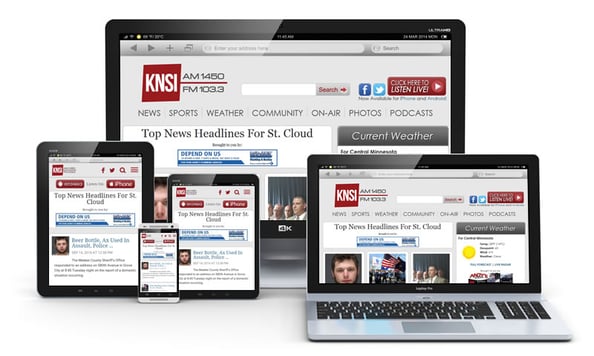Nearly every radio station today has a website. Many have active websites that are kept up-to-date with fresh content. Some have taken it a step further and placed banner ad positions throughout their site. Few have truly mastered the use of display banners on their websites by integrating them with their content, shows, and sections.
Before I get any further into this topic, you should be familiar with digital advertising terminology. Check out this post for a quick glossary of terms you should know.

You’ve probably read that banner ads are not worth it anymore because they don’t perform as well as other digital marketing techniques. Unfortunately, when it comes to display banners on your run-of-the-mill website, yes - they’re probably not worth your hard earned money.
However, for radio station websites – and really for any media outlet’s website like a newspaper or television station - display banners serve a dual purpose if you’re already running a traditional ad campaign with that company.
Radio stations, for example, want to drive traffic to their website to engage listeners while they’re not tuned in. If you’re advertising on-air with that station, and also on their website, you’ll get extra online exposure you won’t get on most “non-media” websites. Media outlets (radio, television, newspaper) have a listener/viewer/reader base and it benefits them to send those folks back to their website for more information.
Since the main goal of your overall advertising efforts is to function together towards a mutual result for your business, display banners on a media website are far and away a better investment than display banners on non-media websites.
Think of it like this:
Let’s say you want to run display banners for your business. You’re entertaining two proposals. One is from an agency, who can place your banners on various websites for you. The other is from a radio station account exec who’s discussing an advertising + display package on their radio stations and corresponding websites.
If you go with the agency, you’ll just get banners placed on various websites. Depending on your banner creative, you’ll get around the average number of clicks on those banners.
On the other hand, if you choose the radio station + website option, you’ll still get the banners and similar clicks. But, you’ll also get on-air exposure, which adds brand awareness for your business. When those listeners go to the station website and see your banners there, it’ll make a mental connection with their neural synapses between your on-air message and your online image. Thus, solidifying your company firmly in their brain.
But Don’t Visitors to the “Other Websites” Also Listen to the Radio?
Sure they do. But you don’t know for sure, nor do you know which stations they listen to. So you’ll never know if they heard your ad on that station. When you place your banners on a station website, you know for a fact that visitors to their website are listeners of that station, and there’s a good chance they’ve also heard your on-air ads. Which option sounds like the safest bet?
The Next Generation of Display Banners
We’re well aware that display banners are declining, but also that your business needs to be marketing online. Which is why we’re constantly innovating to bring better results to our advertisers who want to be on our websites.
The next “big thing” in the online advertising world is called Native Advertising:
“Native advertising is a form of paid media where the ad experience follows the natural form and function of the user experience in which it is placed.” - Sharethrough
So, what does that mean? Form and function refer to banners that don’t look like banners, and they’re not placed like banners. Users have become banner blind over the years, thanks to all those flashy, trashy, “you’ve won a TV for being the One Millionth Visitor” type of ads.
Native ads, on the other hand, are not meant to trick or deceive users. They’re intended to offer value through the natural flow of content on a website.
We’re Already Doing This
Our stream player sponsorships and news station advertorials are examples of native ads that are naturally woven into the look and feel of the content around them. They’re not intrusive, nor are they deceptive to the users. It’s a win/win for the advertiser and user.
The best part is these ad types have the highest click-through rate (CTR) of any other positions.
Best Practices for Display Banners
Like they say in real estate, it’s all about location, location, location. Well, display ads are all about design, design, and design. The design of your banner has a huge impact on your CTR.
Here are some tips for design:
- Use one message per banner
- Use as few words as possible
- Use a clear and compelling call-to-action
- Use images that resonate with the viewer
Finally, your reason to click should be clear and offer a level of value to the users. Display banners that implement those tips will exceed the average click through rate.
Banner ads on radio station websites also work quite well for branding campaigns. If you’re branding on-air, your website banners should mimic the same message. You may not have an offer for the user to claim, but a compelling button to get them back to your website is always a good idea.
For a look at some clients who have a solid strategy for combining on-air and online advertising, check out our Best Radio Strategies eBook.
